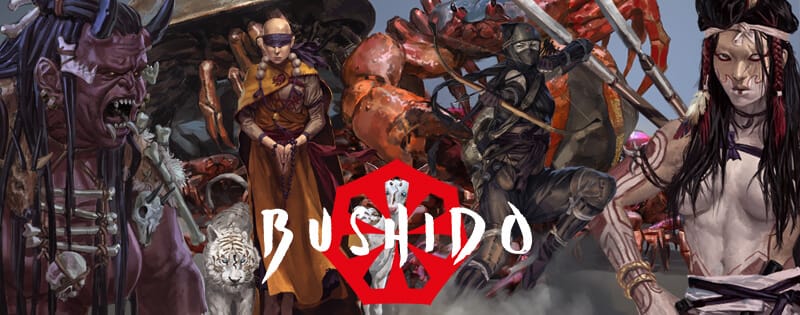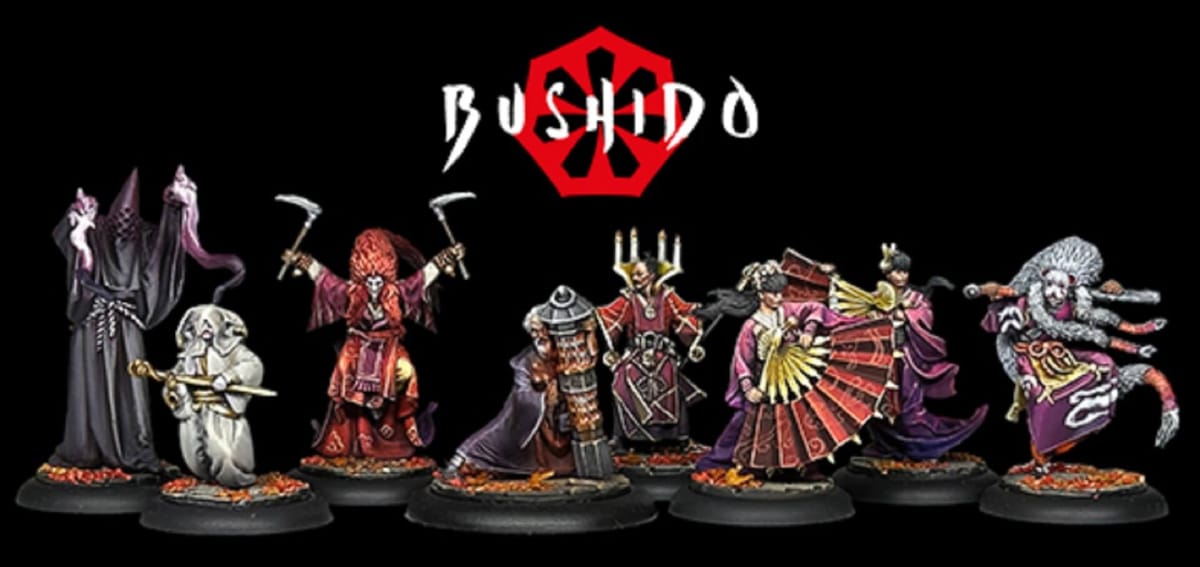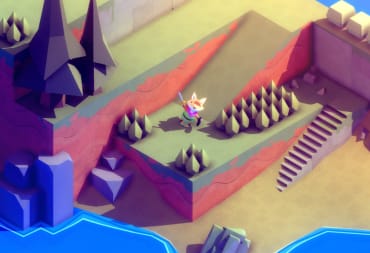The Silvermoon Trade Syndicate, traders, entertainers, merchants, the most powerful crime syndicate on the Jwar Isles? What they lack in overt power, they more than make up for in control, subversion, and tricks.
In this article, we'll have a look at the new Path of a Thousand Names Themed Warband starter set for Bushido Risen Sun. We'll have a look at what's in the box, and where to go from there.
We've been covering Bushido for years, so if you'd like to learn more about the game, check out our guide to Bushido Risen Sun, our review of the Bushido Risen Sun 2-player starter set, and our "Start Collecting" guide to Bushido, which includes an interview with the game's developer.

What's a Themed List in Bushido?
When selecting a warband in Bushido, you must first choose a Faction from the 12 available. Each faction also has access to Theme cards, which offer special abilities, but restrict the units that can be included in the warband.
Introducing: The Path of a Thousand Names
The Path of a Thousand Names comes from the Silvermoon Trade Syndicate faction, and so can be included in any Silvermoon warbands. Alternatively, you can use a theme card like Path of a Thousand Names which only allows Kabuki, Shatei (without the command trait), and Yokai models. It then allows the Path player to roll a number of dice equal to the models they have in the warband at the start of the game. Each dice roll of 6 gives a luck token they can give to any model. Luck tokens allow the player to reroll a dice for that model or a nearby model. The rest of the dice rolls go into a pool, and then during play, the player can exchange a matching dice roll with one of the pool dice to change it to a 6.

Who Are The Path Of A Thousand Names?
On a travelling stage, kabuki actors tell their tales in day-long performances augmented with lantern lights, shadows and dancers. Each performer also has a solo display to bring in the crowds and to entertain during intervals.
The troupe's travel are no random or dictated by te audiance, as the Silvermoon must do their business secretly. And which Prefecture patrol would suspect the villagers' favourite entertainment of smuggling, theft, or assasination.
The Path of a Thousand Names is a brand new themed box release for Bushido Risen Sun. They fall under the Silvermoon Trade Syndicate faction, but by taking the Path of a Thousand Names theme card, it gives you access to the powerful ability on the Theme card, and also some great events and enhancements, like the Shumei event, which when a kabuki model dies, lets you use their ki feats on another friendly kabuki model in play, keeping abilities that you may need in play.
Why Play The Path Of A Thousand Names?
The Path Of A Thousand Names offers Silvermoon Trade Syndicate players a variety of new ways to disrupt your opponent. The Silvermoon are known for their manipulation tactics, as well as their ability to bring brute force when required. The Path offers more of this, with more interference options and some melee shatei models to back them up, along with some solid flanking options.

Where Should I Start With The Path Of A Thousand Names?
The best place to start with the Path of A Thousand Names is with the themed box. It contains 8 miniatures. It also has 1 theme card and 12 special cards, all of which are restricted to the Path of a Thousand Names theme.
The units included in the Path of a Thousand Names-themed box are:
- Kokei - The narrator, likes to keep things on script by controlling everything. When in play, enemies can't gain additional activation counters during the main phase, and he has access to 3 ki feats that allow him to interfere with the opponent's models. The first, Hero's Dilemma, makes your opponent choose two actions for a model, you veto one and the model must perform the other. This is a great way to force a suboptimal use of an enemy activation. The second ki feat, Set the Scene, places a 50mm terrain piece on the battlefield until the end phase of that turn. The third ki feat, Stir Emotion can put up to 4 markers on an enemy with 4 success levels in the test. In defense, their Illusion melee weapon has the Impenetrable Defence ability, which means your opponent discards their highest dice rolled in attack (unless they have Sixth Sense or Aware).
- Tsukai and Ningyo - Tsukai is an empowered abused puppet, that now controls the boy who previously controlled him. Both Tsukai and Ningyo's models come as a pair but have their own stat cards. When Tsukai uses ki feats, they're measured from the Ningyo model instead, and when Tsukai uses ki tokens, they're placed on Ningyo (who doesn't generate his own ki) for his Obey Your Master ki feat. Tsukai's ki feats allow you to move an enemy, stop them using certain offensive abilities, and allow themselves and Ningyo to regenerate.
- Sensu & Uchiwa - These fan dancers also come as a pair, with a shared stat card and acting in the same activation. They work as bodyguards to other fan dancers, switching places with them when they're engaged nearby. Their ki feat Distracting Fan lets fan dancers move away from ranged attacks and ki feats that target them, and their fans allow them to offer cover to other models, helping protect other units as they move up.
- Daitan - This kabuko actor has the Dramatic Entrance ki feat, which means that all enemy models turn to face them when they enter from the flank, and their move characteristic is based on the turn number of the game. To act out the final scene, their melee pool and ki stat are also doubled in the last turn of the game, making them a threat when coming in from the flank if left unchecked by your opponent.
- Arakan - The other kabuki actor in the themed box can deploy into the very center of the battlefield when using flank and their Path of Flowers ki feat and along with Daitan, their move characteristic is based on the turn number of the game, and their melee pool and ki stat are doubled in the last turn of the game.
- The Gaijin - This performer uses light and shadows, and as result, they're always considered to have cover. They can place a variety of Shadow terrain features, such as the Animal Shadow, which can damage enemy models that move through it. They also have the Fear trait, which is variable depending on how many shadow markers are on the battlefield. They also come armed with a Dancing Shadows ranged weapon that not only ignores cover but is boosted when your opponent would normally benefit from it.

What Products Are Available For The Path Of A Thousand Names And Where Should I Go Next?
The Path of a Thousand Names theme card allows for a large number of Silvermoon Trade Syndicate models already in the range. Kaede is an existing Kabuki model and there are several Shatei models that can be used. Below are my favorite models to add in.
- Fudo, the Illuminator - Fudo deploys with 2 lanterns which can be used with his Spotlight ki feat, which works well with the Kabuki models. When used, nearby Kabuki gain kata, which helps them in combat, and Kabuki not nearby gain insignificant, which reduces their ability to assist with combat and perform mission actions. Fudo can also use the Signal ki feat to activate multiple nearby Kabuki models to overwhelm enemy threats.
- Tsubaki - One of the Roses, and is great for helping control the game. With the Seduction ki feat, Tsubaki reduces the ability of an enemy model to have an effect on the game, and with her blinding power ranged attack, she can blind enemies so they can't charge, or make ranged attacks. She can mess with your opponent's plans, and make them activate suboptimally so that you can make the best use of your own models.
There are several other models that the Path can use, but if you're new to the Silvermoon, it's advisable to play a few games with the themed box so you can see what style of play you enjoy before picking up the models to help boost that style.
The copies of the Bushido Path Of A Thousand Names Products used to produce this guide were purchased by the author.
Have a tip, or want to point out something we missed? Leave a Comment or e-mail us at tips@techraptor.net













